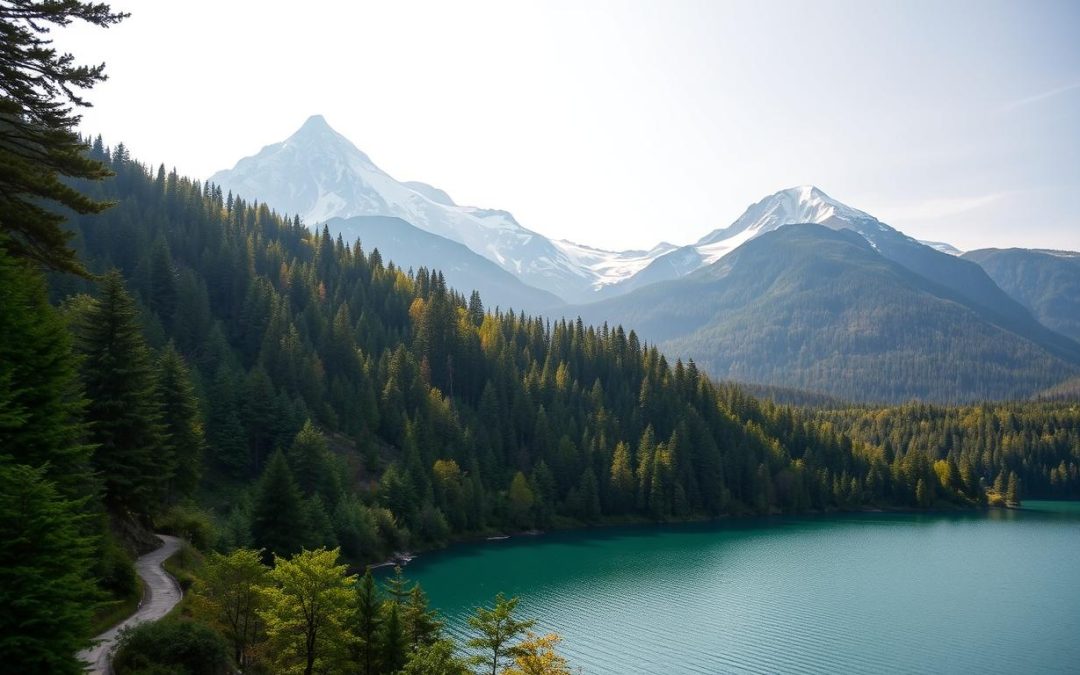Have you ever wondered where you can find a perfect blend of nature, culture, and history, all within a short distance from a bustling city? This destination offers just that and more. Less than two hours from Tokyo, it’s a serene escape that feels worlds away.
Here, towering trees, cascading waterfalls, and breathtaking mountain views create a stunning backdrop. You’ll also discover serene shrines and cultural landmarks that tell stories of the past. Whether you’re seeking adventure or tranquility, this place has something for everyone.
Ready to explore? This guide will help you uncover the must-see spots and hidden gems that make this destination unforgettable.
Key Takeaways
- Easily accessible from Tokyo, making it a convenient getaway.
- Features a mix of natural beauty, cultural landmarks, and historical sites.
- Home to serene shrines and stunning waterfalls.
- Offers panoramic views of mountains and lakes.
- Perfect for both adventure seekers and those looking for relaxation.
Introduction to Nikko National Park
Looking for a peaceful retreat just a short trip from the city? This destination offers the perfect escape from Tokyo‘s fast-paced urban life. With its serene atmosphere and stunning landscapes, it’s a place where you can truly unwind and reconnect with nature.
A Tranquil Escape from Tokyo
Just a couple of hours from Tokyo, this area feels like a world away. Towering trees, quiet trails, and the soothing sound of waterfalls create a calming environment. It’s an ideal spot for those seeking a break from the noise and stress of city living.
Rich Natural and Cultural Heritage
This place is more than just a natural haven. It’s also home to ancient shrines and temples that tell stories of Japan’s rich history. The iconic Kegon Falls and serene lake add to the area’s charm, making it a must-visit for both nature lovers and history enthusiasts.
Whether you’re exploring the cultural landmarks or simply soaking in the peaceful surroundings, this destination promises a rejuvenating experience. It’s a place where you can slow down, breathe deeply, and enjoy the beauty of the moment.
Planning Your Trip: How to Get There and Around
Planning a getaway from Tokyo? Here’s how to make your trip smooth and stress-free. Whether you’re traveling by train or bus, this guide will help you navigate your way with ease.
Navigating Transportation Options
The most convenient way to reach this destination is by train. Tobu’s limited express service from Asakusa Station takes about two hours. If you’re looking to save money, rapid and local trains are also available, though they add around 30 minutes to your travel time.
For those with a JR Pass, you can use JR East trains as an alternative. The JR East Pass (Tohoku area) allows unlimited travel for five days within a 14-day period, making it a great option for exploring beyond this area.
Benefits of Using the Nikko Pass
One of the best ways to save on transportation is by using the Nikko Pass. It covers round-trip travel from Tokyo and unlimited bus rides in the area. This pass can save you around 3,000 yen compared to buying individual tickets.
Here’s a quick comparison of transportation options:
| Option | Cost | Travel Time |
|---|---|---|
| Tobu Limited Express | 2,900 yen (one way) | 2 hours |
| Rapid/Local Train | 1,450 yen (one way) | 2.5 hours |
| Nikko Pass | 4,600 yen (round trip) | 2 hours |
Once you arrive, local buses run every 15 minutes between train stations and major sites. The Tobu World Heritage Sightseeing Bus is a convenient option for exploring key attractions.
With these tips, you’ll have no trouble making the most of your trip. Plan ahead, and enjoy every moment of your journey!
Where to Stay: Choosing Between Nikko Town and Lake Chuzenji
Deciding where to stay can make or break your travel experience. Whether you prefer the convenience of a central location or the tranquility of nature, this area offers two distinct options: Nikko Town and Lake Chuzenji. Each has its unique charm and advantages, so your choice depends on what you want from your trip.
Accommodations in Nikko Town
If you’re looking for easy access to historical sites and public transportation, Nikko Town is the ideal base. This area is home to iconic shrines and temples, making it perfect for history enthusiasts. You’ll also find a variety of accommodations, from budget-friendly hostels to traditional ryokans with onsen experiences.
Staying here means you’re close to major attractions and can easily explore the town’s cultural landmarks. Plus, the convenience of nearby train and bus stations makes it a practical choice for travelers.
Staying Near Lake Chuzenji for Nature Lovers
For those seeking a peaceful retreat surrounded by nature, Lake Chuzenji is the place to be. This area is a haven for hikers and outdoor enthusiasts, with trails offering stunning views of the lake and mountains. Accommodations here range from cozy lodges to luxury ryokans, many with private onsen baths.
Staying near the lake allows you to wake up to serene landscapes and enjoy activities like hiking, boating, and photography. It’s the perfect choice if you want to escape the hustle and bustle and immerse yourself in nature.
When choosing your lodging, consider what type of view and ambiance you desire. Whether you prefer the cultural richness of Nikko Town or the natural beauty of Lake Chuzenji, both options promise a memorable stay.
Must-See Attractions: Temples, Shrines, and UNESCO Sites
Step into a world where history meets artistry, surrounded by serene landscapes and architectural marvels. This area is home to some of the most iconic cultural landmarks, each offering a unique glimpse into the past. Whether you’re a history enthusiast or a nature lover, these sites promise an unforgettable experience.
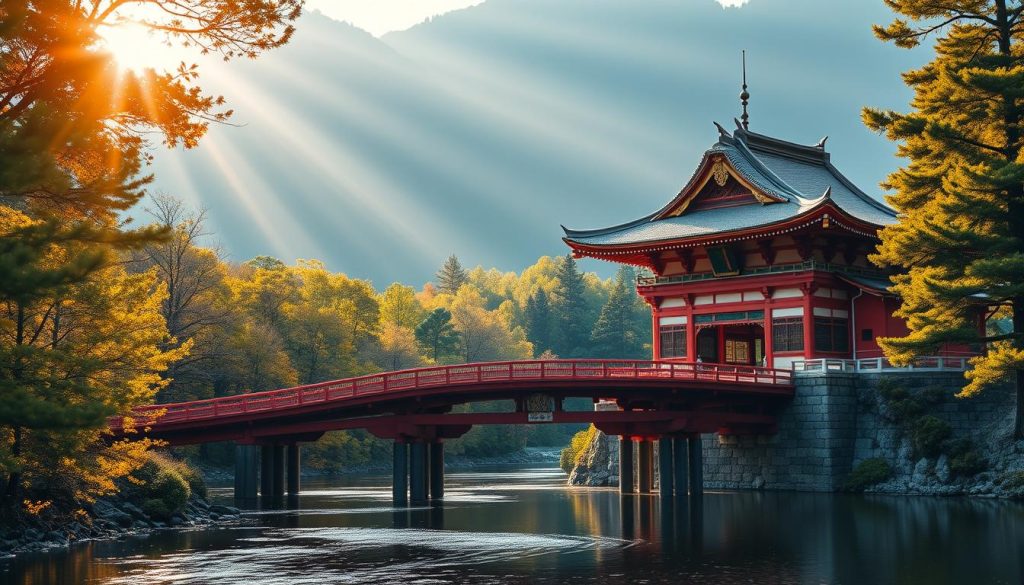
Toshogu Shrine and Taiyuin Temple
The Toshogu Shrine is a masterpiece of ornate architecture, dedicated to Tokugawa Ieyasu, the founder of the Tokugawa shogunate. Its intricate carvings and vibrant colors make it a visual feast. The shrine underwent major renovations in 1636, with 55 buildings reconstructed in just over a year. Today, it stands as a testament to Japan’s rich history and craftsmanship.
Nearby, the Taiyuin Temple offers a more tranquil atmosphere. Nestled amidst lush forests, this site is the mausoleum of Ieyasu’s grandson. Its serene surroundings make it a perfect spot for reflection and photography.
Iconic Shinkyo Bridge Highlights
The Shinkyo Bridge is one of Japan’s most picturesque landmarks. Known as one of the country’s three greatest bridges, it spans the Daiya River with striking elegance. According to legend, a mythical creature once crossed this bridge, adding to its allure. Its vibrant red color and scenic backdrop make it a favorite among photographers.
These attractions form a cohesive cultural itinerary, perfect for a day of exploration. From the grandeur of Toshogu Shrine to the tranquility of Taiyuin Temple and the charm of Shinkyo Bridge, each site offers something special.
| Attraction | Admission Fee (Adults) | Admission Fee (Students) |
|---|---|---|
| Toshogu Shrine | ¥1300 (US$12) | ¥1000 (US$10) |
| Shinkyo Bridge | ¥500 (US$4.75) | ¥300 (US$2.8) |
Plan your visit to these must-see landmarks and immerse yourself in their timeless beauty and tradition.
Top Natural Wonders in Nikko National Park
Discover the breathtaking natural wonders that make this area a must-visit destination. From towering waterfalls to panoramic views, these attractions offer unforgettable experiences for every traveler.
Kegon Falls and Ryuzu Falls
Kegon Falls is a true marvel, with a dramatic 97-meter drop that ranks it among Japan’s most beautiful waterfalls. Accessible observation decks let you admire its power and beauty up close. For a small fee, you can take an elevator to the lower deck for an even more immersive experience.
Ryuzu Falls, known as the “Dragon Head Waterfall,” is a twin cascade surrounded by lush greenery. It’s a quick yet memorable stop, perfect for those exploring the town and its surroundings. Both falls are easily reachable by local buses, making them convenient additions to your itinerary.
Akechidaira Ropeway Scenic Views
For a unique perspective of the entire area, hop on the Akechidaira Ropeway. In just a few minutes, you’ll be treated to breathtaking aerial views of mountains, lakes, and forests. The observation platform at the top offers a perfect spot for photos and soaking in the scenery.
This attraction is a must for anyone looking to capture the essence of the region. Whether you’re a nature lover or a photography enthusiast, the ropeway provides an unforgettable experience.
These natural wonders are essential stops on any guide to this charming town. Plan your visit to make the most of these stunning attractions and create lasting memories.
Experiencing the Best Hiking Trails
If you’re eager to explore the great outdoors, this place offers some of the most rewarding hiking trails you’ll find. Whether you’re a beginner or an experienced hiker, there’s a path that suits your skill level. These trails are a fantastic way to immerse yourself in the world heritage of natural beauty.
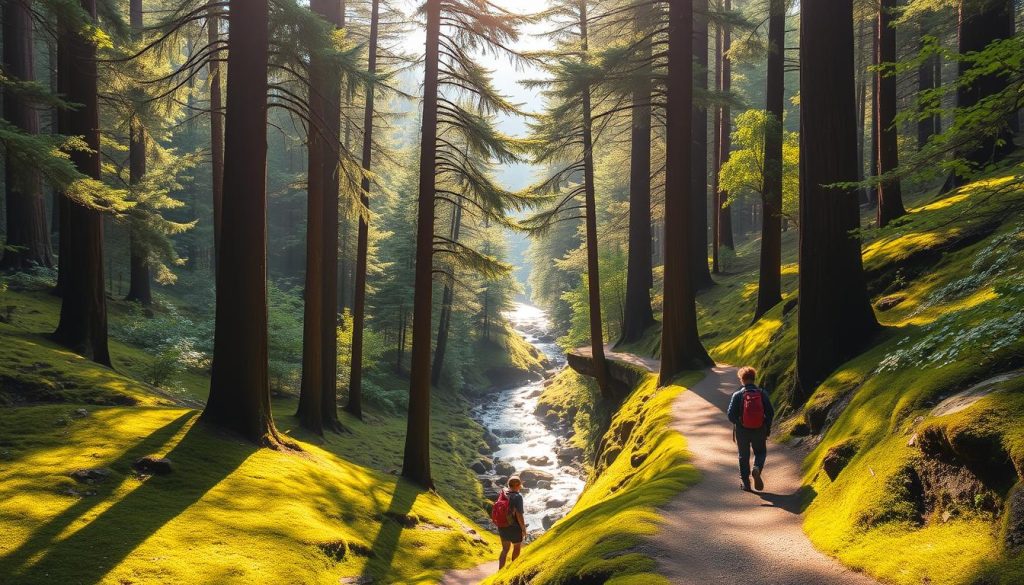
Senjogahara Marshlands Adventures
The Senjogahara Marshlands are perfect for those seeking an easy yet scenic hike. Boardwalks wind through the marsh, offering breathtaking views of the surrounding landscape. This trail is ideal for families or anyone looking for a relaxed outdoor experience.
Plan for about 2-3 hours to complete the loop. The flat terrain makes it accessible for all fitness levels. Don’t forget your camera—the marshlands are a photographer’s dream, especially during sunrise or sunset.
Summiting Mount Nantai for Epic Vistas
For a more challenging adventure, consider summiting Mount Nantai. Often compared to Mount Fuji, this hike rewards you with panoramic views of the entire place. The trail is steep and requires good physical fitness, but the effort is worth it.
Allow 5-6 hours for the round trip, depending on your pace. Start early to avoid afternoon heat and ensure you have enough daylight. Proper hiking boots and plenty of water are essential for this journey.
Both trails offer a unique way to experience the world heritage of this region. Whether you choose the serene marshlands or the rugged mountain, you’re in for an unforgettable adventure.
Nikko National Park, Japan: Best Things to Do – Top Picks
From majestic waterfalls to historic bridges, this destination offers a mix of natural and cultural wonders. Each attraction adds to the charm, making it a must-visit for travelers seeking beauty and history.
One of the highlights is Kegon Falls, a breathtaking cascade that drops 97 meters. Its power and beauty are unmatched, and the observation decks provide stunning views. For a small fee, you can take an elevator to the lower deck for an even closer experience.
Another iconic spot is the Shinkyo Bridge, known for its vibrant red color and scenic backdrop. Legend has it that a mythical creature once crossed this bridge, adding to its allure. It’s a favorite among photographers and history enthusiasts alike.
These landmarks are part of the area’s rich heritage, offering a glimpse into Japan’s past. The intricate designs and cultural significance make them unforgettable. Whether you’re drawn to the natural beauty or the historical depth, there’s something for everyone.
Here’s a quick summary of the top attractions:
| Attraction | Highlight |
|---|---|
| Kegon Falls | 97-meter drop, observation decks |
| Shinkyo Bridge | Vibrant red, legendary history |
| Toshogu Shrine | Ornate architecture, UNESCO site |
For a complete picture of what this destination has to offer, revisit the earlier sections of this guide. Each attraction adds to the collective beauty and cultural richness, making it a truly unique travel experience.
Seasonal Delights: Activities for Every Time of Year
Every season brings its own magic to this destination, offering a variety of activities that cater to all interests. Whether you’re visiting in spring, summer, autumn, or winter, there’s always something special to experience. From blooming landscapes to festive celebrations, each season adds a unique charm to your trip.
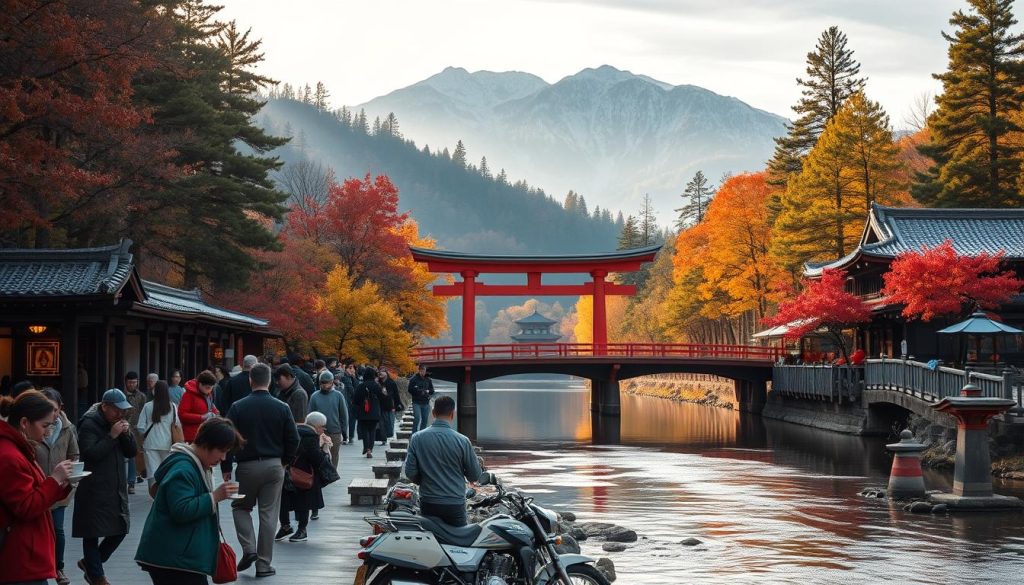
Spring and Summer Outdoor Adventures
Spring is a time of renewal, with cherry blossoms painting the landscape in soft pinks and whites. Explore the serene sites surrounded by blooming flowers, or take a leisurely boat ride on the lake. The mild weather makes it perfect for hiking trails, where you can enjoy panoramic views of the area.
Summer brings vibrant energy, with opportunities for water sports and outdoor festivals. Visit local sites to learn about the region’s history, or join a guided tour to discover hidden gems. Don’t forget to check seasonal ticket prices, as some attractions offer discounts during this time.
Autumn Foliage and Winter Festivals
Autumn transforms the area into a canvas of red, orange, and gold. The colorful foliage creates a breathtaking backdrop for hiking and photography. Take a stroll through the forests or visit iconic sites to witness the beauty of the season.
Winter is a magical time, with snow-covered landscapes and festive celebrations. Enjoy traditional onsen experiences or attend local festivals that showcase the region’s culture. Many attractions have extended operating hours during this season, so plan your visit accordingly.
No matter when you visit, this destination offers unforgettable experiences. Each season highlights a different aspect of its charm, making it a place you’ll want to return to year after year.
Cultural Experiences and Local Cuisine
Immerse yourself in a world of flavors and traditions that define this region’s cultural richness. From savory dishes to intricate crafts, every experience offers a glimpse into the area’s heritage. Whether you’re a foodie or a history buff, there’s a lot to discover here.
Tasting Local Specialties: Yuba and Tochigi Wagyu
One of the highlights of the local cuisine is yuba, a delicate tofu skin that’s a staple in traditional dishes. It’s often served in soups or as a side dish, offering a unique texture and flavor. Pair it with Tochigi Wagyu, a premium beef known for its marbling and tenderness, for a truly indulgent meal.
Local eateries like Watanabe Sahei Shoten and Katayama Shuzo breweries provide a perfect setting to enjoy these dishes. These establishments have been around for centuries, offering a blend of history and flavor. They’re also great places to learn about the brewing process of sake, a traditional Japanese rice wine.
Exploring Traditional Crafts and Sweet Treats
Beyond food, the region is famous for its traditional crafts. Nikko woodcarving is a must-see, with intricate designs that reflect the area’s artistic heritage. You can also find locally made sweets like yokan, a confection made with adzuki red bean paste and agar. These treats were once given to pilgrims visiting local shrines and temples.
Exploring these crafts and sweets adds depth to your travel experience. They offer a tangible connection to the region’s history and culture, making your trip even more memorable.
| Experience | Highlight |
|---|---|
| Yuba Tofu | Delicate texture, versatile dishes |
| Tochigi Wagyu | Premium beef, rich flavor |
| Nikko Woodcarving | Intricate designs, cultural heritage |
| Yokan Sweets | Traditional confection, historical significance |
These cultural experiences provide easy access to the region’s authentic flavors and traditions. They’re a testament to the enduring legacy of figures like Tokugawa Ieyasu, whose influence continues to shape the area’s identity. Whether you’re savoring a meal or admiring a craft, you’re sure to leave with a deeper appreciation for this vibrant world.
Off the Beaten Path Adventures
For those who crave a deeper connection with nature and history, there’s a world of hidden gems waiting to be discovered. Beyond the well-trodden routes, you’ll find serene temples, remote trails, and quiet villages that offer a more intimate experience of this destination.
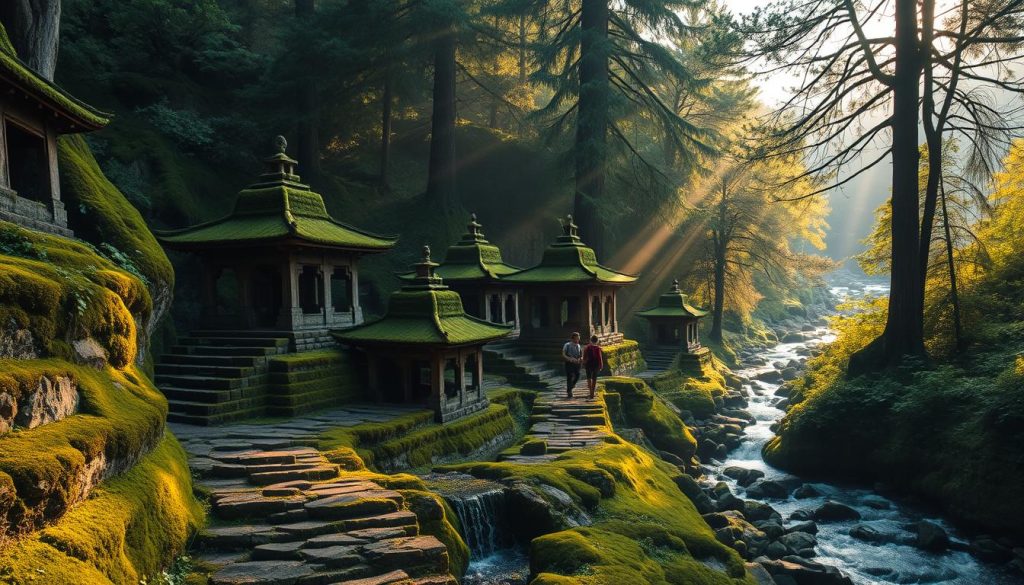
Hidden Temples and Remote Trails
While the iconic shinkyo bridge and popular shrines draw crowds, there are lesser-known spots that promise tranquility. Explore hidden temples tucked away in lush forests or follow remote trails that lead to breathtaking vistas. These paths are perfect for those seeking solitude and a closer connection to the surroundings.
To reach these secluded spots, start your journey from the main station. Local buses and walking paths make it easy to navigate rural areas. Be sure to wear comfortable shoes and carry a map, as some trails are less marked. The effort is worth it—you’ll discover places few travelers ever see.
Examples include the peaceful Taiyuin Temple, nestled in a quiet forest, and the lesser-known trails around Lake Chuzenji. These spots offer a chance to experience the area’s beauty without the crowds. You’ll also find small villages where locals welcome visitors with warm hospitality.
Venturing off the beaten path rewards you with authentic experiences and unforgettable memories. Whether it’s a quiet moment at a hidden shrine or a stroll through a remote village, these adventures add depth to your journey. So, step away from the crowds and uncover the secrets of this destination.
Budget Travel Tips and Essentials
Exploring this destination doesn’t have to break the bank—here’s how to make the most of your trip on a budget. With smart planning and a few insider tips, you can enjoy all the highlights without overspending. From transportation to dining, here’s your guide to traveling affordably.
Saving Money with Passes and Local Deals
One of the easiest ways to save is by using the Nikko Pass. This pass covers round-trip travel and unlimited bus rides, saving you around 3,000 yen compared to buying individual tickets. It’s a must-have for budget-conscious travelers.
For attractions, look for combo tickets or discounted entry during off-peak hours. Many onsen facilities offer early bird or evening discounts, so plan your visits accordingly. Local deals can stretch your budget further.
Here are some practical tips for saving money:
- Use the bus system efficiently—plan your route to avoid unnecessary trips.
- Visit free attractions like scenic parks and walking trails.
- Take advantage of tax-free shopping for purchases over 5,000 yen.
Affordable Dining and Accommodations
Finding budget-friendly meals is easy if you know where to look. Local eateries and street vendors offer delicious options at a fraction of the cost of restaurants. Try regional specialties like yuba or Tochigi Wagyu for a taste of the area without the high price tag.
When it comes to lodging, consider staying in Lake Chuzenji for affordable ryokans or guesthouses. These options often include amenities like private onsen baths, adding value to your stay.
Here’s a quick comparison of daily expenses:
| Expense | Cost (Approx.) |
|---|---|
| Meals | 1,500-3,000 yen |
| Accommodation | 5,000-10,000 yen |
| Transportation | 1,000-2,000 yen |
By planning ahead and taking advantage of local deals, you can enjoy a full day of activities without overspending. Whether you’re exploring the park or relaxing in an onsen, these tips will help you make the most of your budget.
Practical Information: Tickets, Passes, and Local Etiquette
Planning your visit to this destination? Here’s everything you need to know about tickets, passes, and local etiquette. Whether you’re exploring iconic landmarks or hidden gems, having the right information ensures a smooth and respectful experience.
Understanding Entry Fees and Pass Options
To make the most of your tour, it’s essential to understand the ticketing system. Many attractions require separate entry fees, but passes like the Nikko Pass can save you money. This pass covers round-trip travel and unlimited bus rides, making it a cost-effective choice.
Here’s a breakdown of popular pass options:
| Pass | Coverage | Cost |
|---|---|---|
| Nikko Pass | Round-trip travel, unlimited bus rides | 4,600 yen |
| JR East Pass | Unlimited JR train rides (5 days) | 20,000 yen |
| World Heritage Pass | Entry to major shrines and temples | 1,300 yen |
For those visiting in autumn, consider purchasing tickets in advance to avoid long lines. Many attractions offer discounts during off-peak hours, so plan accordingly.
Local Customs and Travel Essentials
Respecting local customs is key to a seamless visit. When visiting shrines, remember to bow slightly before entering and avoid loud conversations. Public transportation, especially around nikko station, can get crowded, so be mindful of personal space.
Here are some essential tips:
- Remove shoes before entering traditional accommodations or certain cultural sites.
- Carry cash, as some smaller establishments may not accept credit cards.
- Dress in layers, especially in autumn, as weather can change quickly.
By following these guidelines, you’ll not only enjoy your trip but also show respect for the local culture. With the right passes and etiquette, your visit will be both memorable and hassle-free.
Conclusion
Whether you’re drawn to serene landscapes or rich history, this destination offers a perfect blend of both. From the majestic mountains to the intricate beauty of Toshogu, every corner tells a story. No matter the time of year, there’s always something special to experience—whether it’s cherry blossoms in spring or snow-covered trails in winter.
Exploring both famous and offbeat attractions ensures a well-rounded adventure. Don’t miss the Shuki Taisai Grand Autumn Festival, a vibrant celebration of local culture. Practical tips, like using the Nikko All Area Pass, make your journey smoother and more affordable.
This guide is your key to planning an unforgettable trip. Pack your bags and get ready to discover a place where nature, history, and charm come together seamlessly.
The above is subject to change.
Check back often to TRAVEL.COM for the latest travel tips and deals.
Here are some Tours & Sightseeing suggestions that might pique your interests!
